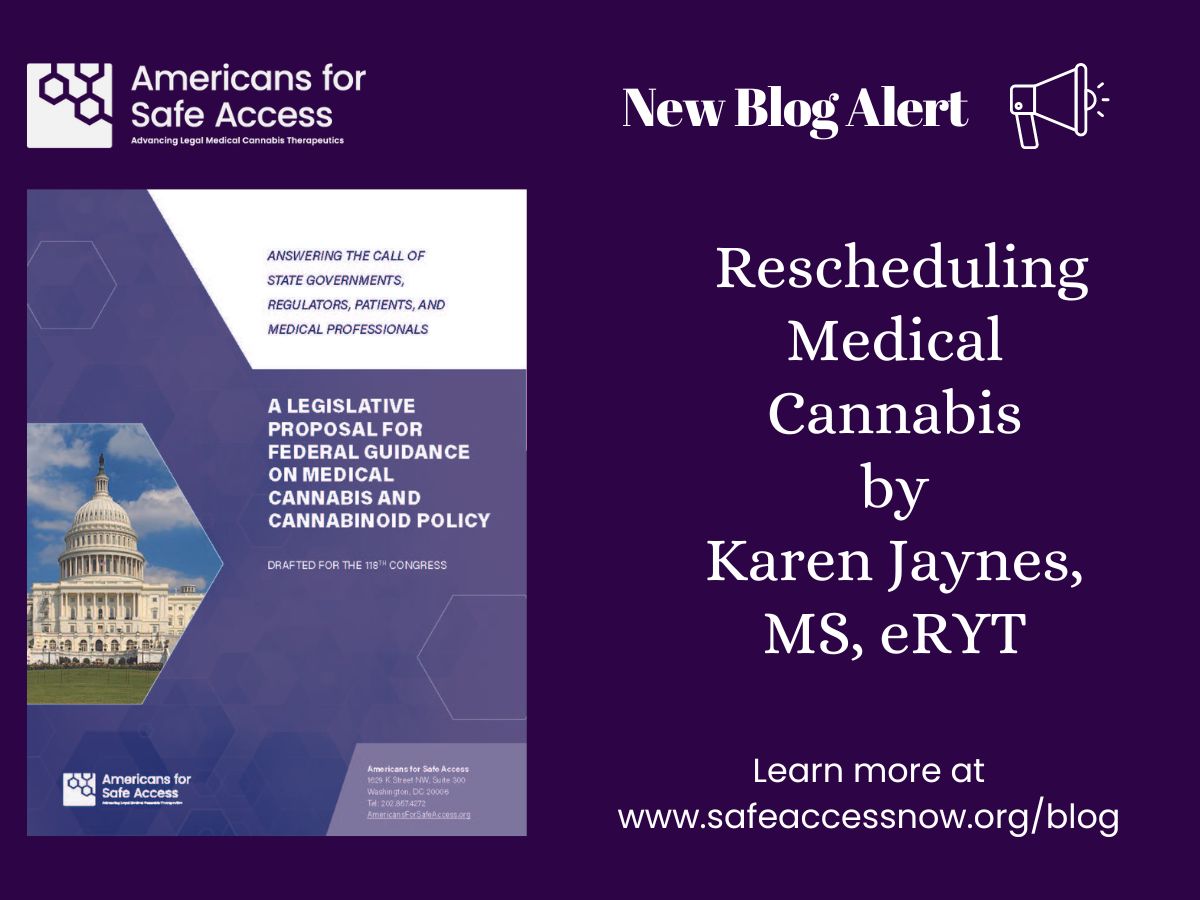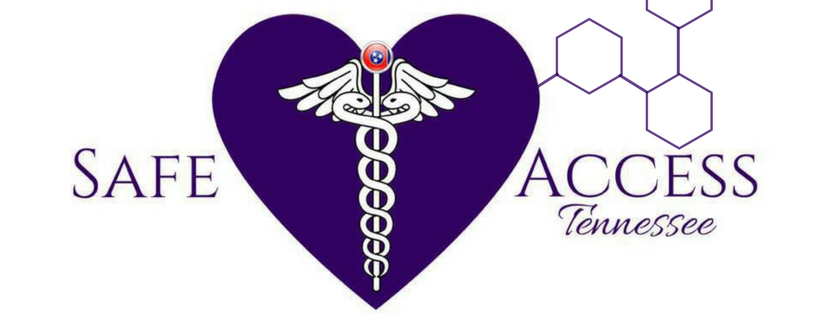
This post was originally published on SafeAccessNow.com
Posted by Karen Jaynes on August 01, 2023
A New Agency – the Office of Medical Cannabis and Cannabinoid Control (OMCCC) proposed by Americans for Safe Access (ASA)
By Karen Jaynes, August 1, 2023
In this past year, I have had the opportunity to dig deep into the discussions, written drafts and opinion papers of policy makers, change influencers, industry stakeholders, academics and advocates of cannabis. Having recently graduated with my masters in science in Medical Cannabis Science & Therapeutics from the University of Maryland-Baltimore, I made my own investment in Cannabis, through education. My educational investment in the industry has offered me, through my focus on regulation and policy, the opportunity to collaborate as an advisor with several advocacy and education intermediary organizations focused on federal policy change for medical cannabis patients and a nascent, struggling industry that is supporting them.
Mostly, what is creating this stopgap is the current U.S. federal policy on marijuana (defining marijuana in this article as Cannabis Sativa, L. containing over .03% tetrahydrocannabinol -THC). These policies originated in various legislative stages throughout the 20th century with prohibitive tax laws that became a full blown punitive Controlled Substance Act of 1970 (CSA). Since then, marijuana, among other drugs, many of which are substances used for pain and mental health conditions, have been stigmatized as dangerous enough to warrant the federal executive agencies’ oversight to prohibit and criminalize marijuana use, illicit trafficking and diversion. While there are many substances found on the street today that are lethal and falling into the hands of vulnerable populations looking for solutions, many of these prohibitive substances, through research and evolved science since 1970, have proven to NOT be the deadly and grossly dangerous drugs they were sentenced to be in the CSA. Marijuana is one of them and it continues to be categorized (at the time of this writing) as a Schedule 1 substance, defined by its category as a drug with no recognized medical use and the most highly addictive. And in conflict with this categorization, 38 states and 4 U.S. territories have legalized medical marijuana programs, while 23 states and 3 U.S. territories (including D.C.) have fully legalized marijuana adult use.
And while this brief background is not new to most of you who are reading this, its inclusion is impactful, as we also highlight that there are now four FDA approved pharmaceuticals available in the United States that are derived from Cannabis Sativa, L compounds, either directly from plant abstracts or synthetic isomers of the most commonly known cannabinoids of this time, cannabidiol (CBD) and THC. Three of the four approved pharmaceuticals still remain scheduled drugs (Cesamet, brand name of the drug, nabilone, a synthetically derived THC reported to be more potent than D9-THC is categorized in Schedule 2 along with Syndros, a brand name for dronabinol; Marinol, also a brand name dronabinol and less potent than nabilone, another synthetically derived D9-THC categorized in Schedule 3; and Epidiolex, a brand name for a highly concentrated CBD, a non-psychoactive compound of Cannabis Sativa, L., that is no longer scheduled).
President Biden, on October 6, 2022 announced three approaches he was taking in reforming marijuana policy to include federal pardons for simple possession federal offenses, urging state governors to do the same (where most incarcerated and convicted offenses for marijuana reside), and to charge the Attorney General and Secretary of Health and Human Services to initiate the administrative process to review expeditiously how marijuana is scheduled under federal law.
As part of this charge, the Congressional Research Service quickly responded on October 7, 2022 with several potential options for Congress, one being to create an entirely new schedule or other category for marijuana.
Americans for Safe Access offers this comprehensive response to this option in model legislation that creates the Office of Medical Cannabis and Cannabinoid Control (OMCCC). “The mission of the OMCCC is to facilitate access to medical cannabis for therapeutic use and research, regulate the production of medical cannabis and cannabinoid products, facilitate private-public partnerships for product development and research and oversee the new Schedule VI,” where the OMCCC resides (ASA, 2023).
While I have read many opinions, discussions, proposed and partially passed legislation, both comprehensive and single purpose, the focus of medical purpose and patients are not often prioritized with the most recent exception to our veterans, who have received appropriation considerations this past week in the recently passed Military Spending Bill. This however does not give them or any medical cannabis patient sanctions to cross state lines with medications, find protections under the Americans with Disabilities Act, subsidized housing security, or drug testing considerations in the public or private sectors.
I encourage you to investigate this option with the long view in mind. It is a model that removes punitive law enforcement from substances used to treat physical and mental health conditions, and that in doing so, promotes the dissolution of cultural stigma associated with these conditions, including but not limited to, intractable pain, cancers, Autoimmune Deficiency Syndrome (AIDS), Post Traumatic Stress Disorder (PTSD), severe depression and anxiety, eating disorders and addiction to name a few.
When we have a robust system for underscoring product safety, public health and harm reduction with the most vulnerable patients as a priority, the resulting gold-standards within the industry will benefit all consumers.
The OMCCC will exist within the tiers of Health and Human Services federal agency framework, and in alliance with the Food and Drug Agency (FDA), the Department of Agriculture, (USDA), and the Environmental Protection Agency (EPA) with relationship to the current Cannabis Sativa, L. applications in plant and product routes of administration, while addressing legislation within the Department of Justice, the Internal Revenue Service, Bureau of Alcohol, Tobacco, Firearms & Explosives and Department of Treasury, where prohibitive marijuana laws intersect current federal policies.
And most importantly, while the OMCCC exists in a schedule framework, the Schedule VI does not exist within the Controlled Substance Act criminal codes and sentencing guidelines and looks to a more civil and legal framework for compliance and sustainability.
While the complexities of health insurance coverage remain somewhat uncertain, what is clear is that once the federal government removes marijuana from Schedule 1, the potential for physician recommended and eventually prescribed medical cannabis coverage could become available to those who receive federally subsidized health care, including veterans through the Veterans Administration, and through federally subsidized insurance programs such as Healthcare.gov and Medicaid.
Take a look at the detailed proposal for the Medical Cannabis Patient Equity Act of 2023 that establishes the Office of Medical Cannabis and Cannabinoid Control (OMCCC), its Subdivisions of Medical Cannabis Science and Health, Agriculture and Cultivation, Management, and how it coordinates with non-federal entities, the transition of policy and administration, and the implementation of licensing, distribution, prescription protocols, and amendments to existing legislation.
I believe there is urgency here.
- The differences between federal and state marijuana policies undermine the state of our union’s integrity. We have fallen out of line within international treaty guidelines while grass-roots actions through many state ballot initiatives, have proven what Americans feel is a priority for their healthcare and wellbeing…enough to get out and vote.
- Products without good manufacturing processes and safety standards are being marketed to the public and are falling into children’s hands in convenience stores and gas stations without consistent accountability from state to state on any cannabis products.
- Turning a deaf ear to antiquated stagnate legislation weakens the truth in science and robust medical research needed for solutions to address our complex and ever-increasing chronic health issues.
- While Cannabis Sativa, L. is not a panacea for all that ails us, we do know that it is supporting more than 6 million registered medical patients for hundreds of medical conditions and has found its way into 24 million American homes.
We need comprehensive, responsible, proactive cannabis reform that prioritizes patients, product safety and the normalization of medicines that reestablish a state of homeostasis, public health and individual and institutional wellbeing. I’m invested in medical cannabis and pledge to support all that we need to do to educate, change stigma, promote truth in science, incentivize a compliant industry, and lead the complex and worthy pursuit that is rescheduling cannabis.
